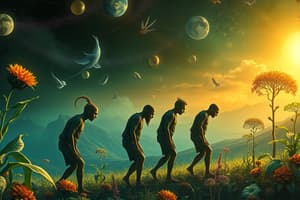Podcast
Questions and Answers
Which of the following characteristics is unique to chordates?
Which of the following characteristics is unique to chordates?
- Jointed appendages
- Bilateral symmetry
- Exoskeleton
- Dorsal hollow nerve cord (correct)
What adaptation allowed early tetrapods to reproduce away from water?
What adaptation allowed early tetrapods to reproduce away from water?
- Limbs
- Jaws
- Amniotic egg (correct)
- Lungs
Which group of vertebrates is characterized by a three-chambered heart?
Which group of vertebrates is characterized by a three-chambered heart?
- Mammals
- Cartilaginous fish
- Birds
- Amphibians (correct)
Which of these characteristics do reptiles share with amphibians?
Which of these characteristics do reptiles share with amphibians?
What type of skeleton do arthropods possess?
What type of skeleton do arthropods possess?
Which characteristic is NOT associated with birds?
Which characteristic is NOT associated with birds?
Which of the following vertebrates is characterized as ectothermic?
Which of the following vertebrates is characterized as ectothermic?
Which type of fish includes the teleosts?
Which type of fish includes the teleosts?
What is a primary reason for the importance of biodiversity?
What is a primary reason for the importance of biodiversity?
Which of the following is a characteristic of plants?
Which of the following is a characteristic of plants?
How do taxonomists organize organisms in a phylogenetic tree?
How do taxonomists organize organisms in a phylogenetic tree?
Which of the following describes multicellular animals?
Which of the following describes multicellular animals?
What type of symmetry do organisms like sponges exhibit?
What type of symmetry do organisms like sponges exhibit?
What distinguishes eukaryotic organisms from prokaryotic ones?
What distinguishes eukaryotic organisms from prokaryotic ones?
What is a key characteristic of the members of the Phrymaceae family?
What is a key characteristic of the members of the Phrymaceae family?
Which of the following statements about animal reproduction is generally true?
Which of the following statements about animal reproduction is generally true?
Flashcards are hidden until you start studying
Study Notes
The Importance of Biodiversity
- Biodiversity is vital for ecosystem health, providing resilience and supporting various economic resources including agriculture and medicine.
- It provides vital services such as clean air and water.
- Biodiversity enriches cultures, supports recreation, advances scientific knowledge, and underscores the inherent value of every species.
Evolution of Life
- Earth formed 4.6 billion years ago (BYA).
- Prokaryotes emerged 3.8 BYA.
- Eukaryotes evolved 2.0 BYA.
- The first animals appeared 635 million years ago (MYA).
What is a Plant?
- Multicellular eukaryotes that produce their own food through photosynthesis.
- Predominantly terrestrial (land-dwelling).
- Sessile (stationary).
- Range in size from 1 millimeter to 380 feet tall.
Understanding Plant Evolution
- Phylogenetic tree: a diagram illustrating evolutionary relationships among organisms.
- Groups are organized by their shared characteristics.
- Key evolutionary milestones for plants include:
- Vascular tissue: allowing for efficient transport of water and nutrients.
- Seeds: facilitating dispersal and providing nourishment for embryos.
- Flowers: attracting pollinators, aiding in sexual reproduction.
Plant Taxonomy
- Taxonomists use a hierarchical system to classify organisms.
- The system follows the acronym "King Phillip Came Over For Great Spaghetti":
- Domain
- Kingdom
- Phylum
- Class
- Order
- Family
- Genus
- Species
The Monkeyflower Family (Phrymaceae)
- Key characteristics:
- Bilateral petals: arranged symmetrically on either side of a central axis.
- Fused petal tube: petals joined together to form a tube-like structure.
- Fused sepals: the outermost protective layer of a flower, fused to form a single structure.
- Simple, opposite leaves: leaves with a single blade, arranged in pairs on opposite sides of the stem.
Defining Animals
- Multicellular, heterotrophic eukaryotes (obtain food from other organisms).
- Lack cell walls.
- Contain collagen for structural support.
- Possess muscle and nervous tissues for movement and nerve transmission.
- Primarily reproduce sexually.
Animal Symmetry
- Asymmetrical: no recognizable pattern of body organization (e.g., sponges).
- Radial symmetry: body parts evenly arranged around a central axis (e.g., sea anemones, starfish).
- Bilateral symmetry: opposite halves of the body are mirror images (e.g., humans, insects).
Sponges
- Key Characteristics:
- Lack tissues or organs.
- Intracellular digestion.
- Asymmetrical.
- Free-swimming larvae.
- Sessile (stationary) adult stage.
Arthropods
- Includes: barnacles, spiders, insects, millipedes, and crustaceans.
- Key Characteristics:
- Protostome development (mouth forms first).
- Bilateral symmetry.
- Alimentary canal (digestive tract).
- Exoskeleton (protective outer covering that is shed for growth).
- Jointed appendages.
- Segmented bodies divided into head, thorax, and abdomen.
Chordates
- Includes: fish, reptiles, birds, and mammals.
- Key Characteristics:
- Deuterostome development (anus forms first).
- Bilateral symmetry.
- Alimentary canal.
- Endoskeleton (internal skeleton).
- Dorsal hollow nerve cord.
- Notochord (flexible rod for support).
- Pharyngeal gill slits (openings in the throat region).
- Post-anal tail.
Vertebrate Phylogeny
- Illustrates the evolutionary relationships among vertebrates.
Fishes
- Key Characteristics:
- Ectothermic (rely on external sources for heat).
- Two-chambered heart.
- Jawless fish:
- Hagfish (primitive, eel-like fish).
- Cartilaginous fish:
- Sharks, skates, and rays (skeleton made of cartilage).
- Bony fish:
- Ray-finned fish:
- Teleosts (majority of bony fish species).
- Lobe-finned fish:
- Lungfish (adapted for breathing air).
- Ray-finned fish:
Transition to Land: Early Tetrapods
- Early tetrapods evolved adaptations allowing them to live on land.
- Key Adaptations:
- Jaws: grasping prey.
- Lungs: breathing air.
- Limbs and modified vertebrae: movement and weight support.
- Amniotic egg: reproduction away from water.
- Internal fertilization: sperm fertilizes the egg inside the female.
Amphibians
- Includes: frogs and salamanders.
- Key Characteristics:
- Approximately 6,150 species.
- Metamorphosis: transformation from aquatic larvae to terrestrial adults.
- Thin, vascularized skin: permeable to water and gases.
- Three-chambered heart: partially separates oxygenated and deoxygenated blood.
- Ectothermic: regulation of body temperature through external sources.
Reptiles
- Includes: snakes, lizards, tortoises, crocodiles, and birds.
- Key Characteristics:
- Ectothermic (except birds): rely on external sources for heat.
- Three-chambered heart (except crocodiles and birds): partially separates oxygenated and deoxygenated blood.
- Scales and scutes: protective outer covering.
- Lungs: for breathing air.
- No embryonic stage with gills: development occurs entirely within the amniotic egg.
Birds
- Includes: ostriches, penguins, kiwis, sparrows, eagles, and albatrosses.
- Key Characteristics:
- Endothermic: regulate their own body temperature.
- Four-chambered heart: completely separates oxygenated and deoxygenated blood.
- Feathers: insulation, flight, and display.
- Wings: for flight.
- Bill with no teeth: adapted for feeding.
- Strong, lightweight skeleton: adapted for flight.
Mammals
- Includes: monkeys, giraffes, rats, tigers, whales, elk, and humans.
- Key Characteristics:
- Endothermic: regulate their own body temperature.
- Four-chambered heart: completely separates oxygenated and deoxygenated blood.
- Mammary glands: produce milk to nourish young.
- Hair: insulation and sensory purposes.
Studying That Suits You
Use AI to generate personalized quizzes and flashcards to suit your learning preferences.




